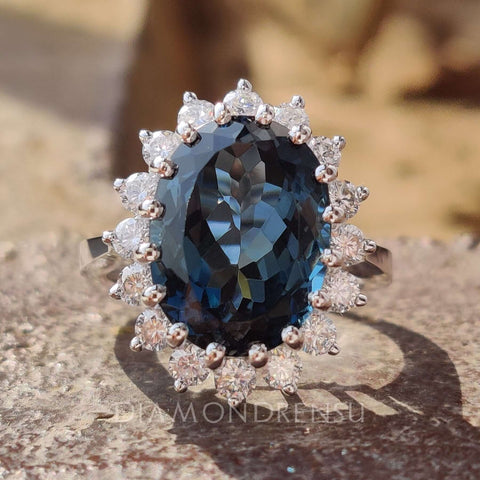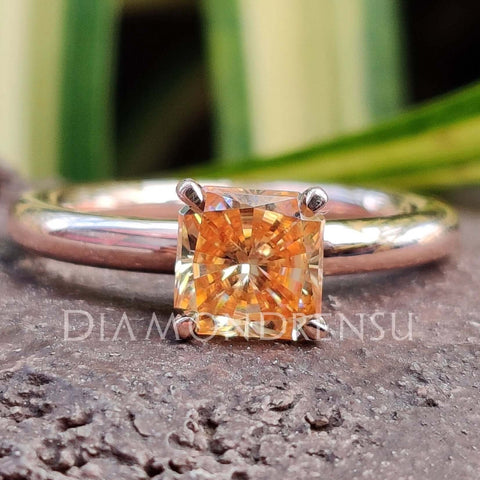
Which Goes First: Engagement or Wedding Ring - A Clear Guide
Determining the proper order in which to wear engagement and wedding rings can be confusing for many couples as traditions and customs often vary. This topic has sparked numerous debates, leading people to adopt different practices according to their cultural norms and personal preferences.
However, there is a common approach to this conundrum, which consists of placing the wedding band on the finger first, followed by the engagement ring. This configuration is based on the belief that the wedding ring should be closer to the heart, symbolizing the bond of marriage.
Shine Bright, Save Big – Your Dream Engagement Ring Is Here!
Engagement rings have long been a token of love and commitment, marking the promise of a future marriage. With intricate designs and elegant appeal, they are an essential part of the pre-wedding phase. There is an extensive array of exquisite options available, such as the moissanite engagement rings that come in various shapes, sizes, and designs, which cater to diverse tastes and budgets.
While understanding the significance of both the engagement and wedding rings is crucial, it is equally important to respect the preferences and beliefs of each individual. The manner in which couples choose to wear their rings ultimately reflects their unique love story, beliefs, and values.
History and Symbolism

The history of engagement and wedding rings can be traced back to ancient traditions. These rings were marked by their unique symbolism and held immense importance in marriages. Over time, the etiquette around wearing engagement and wedding rings has evolved, while certain elements of ancient symbolism continue to be powerful today.
In ancient times, the wedding band was said to represent the vena amoris or the "vein of love". This vein is believed to run directly from the ring finger to the heart, symbolizing the deep emotional connection between partners. Today, this concept remains a popular belief and is one reason why couples exchange rings during their wedding ceremonies.
As the practice of exchanging engagement and wedding rings continued through history, certain etiquette rules emerged. Traditionally, the engagement ring was worn first, followed by the wedding band. This order signified the progression of a couple's relationship, with the engagement representing the acceptance of the marriage proposal and the wedding ring symbolizing their commitment to each other after the wedding.
Engagement and wedding rings have a rich history, filled with symbols of love, commitment, and the promise of a lifelong partnership. While the etiquette behind their use has evolved, the symbolic meaning remains significant in contemporary ceremonies. Couples today can choose from a wide variety of options, such as beautiful moissanite wedding bands, to celebrate their love and make a lasting impression.
Engagement Ring and Wedding Ring Differences

Engagement rings and wedding rings serve different purposes in a couple's journey of love and commitment. Traditionally, the engagement ring is given during a proposal as a symbol of promise and devotion. Often, engagement rings feature a more elaborate design, such as solitaire diamond engagement rings, to signify the importance of the commitment being made.
In contrast, wedding rings are exchanged during the wedding ceremony and represent the couple's lasting commitment as they enter into marriage. Typically, these rings are classic wedding bands made of precious metals such as gold or platinum. Wedding rings tend to have simpler designs compared to engagement rings, signifying the eternal and unadorned nature of the love shared between the couple.
When it comes to wearing both rings, the engagement ring is traditionally worn on the left ring finger before the wedding and moved to the right hand after the wedding ceremony. The wedding band is then placed on the left ring finger during the ceremony, closest to the heart. However, some couples choose to keep both rings on the left hand, with the wedding band worn closest to the heart and the engagement ring on top.
One significant distinction between engagement rings and wedding rings is the choice of materials and design elements. Diamonds are commonly associated with engagement rings, whereas gold, platinum, and other precious metals are more often used in the creation of wedding bands. Some couples decide to add diamonds or other gemstones to their wedding bands, but these stones are typically smaller and more subtle than those found on engagement rings.
In summary, engagement rings and wedding rings have different meanings and purposes in a couple's love story. While the engagement ring symbolizes the promise of devotion and commitment, the wedding ring represents the everlasting bond formed through marriage. Both rings hold great sentimental value, and their distinct designs and materials reflect the unique stages in the journey of love and commitment that they represent.
The Tradition of Wearing Rings

The tradition of wearing engagement and wedding rings can be traced back to ancient times. Typically, couples wear their rings on the left hand, specifically on the ring finger. This custom is believed to have originated from the ancient Romans, who thought that a vein in the left ring finger, known as the 'Vena Amoris,' connected directly to the heart.
In some countries and cultures, however, it is customary to wear wedding and engagement rings on the right hand's ring finger. This choice can be based on cultural, religious, or personal preferences. Irrespective of the hand chosen for wearing rings, the placement of the engagement and wedding rings on one's finger also has a specific tradition.
The engagement ring is traditionally worn first, followed by the wedding ring. The reasoning behind this custom is to symbolize the chronological order of the milestones in a couple's relationship: first, they get engaged, and then they get married. When a couple gets engaged, the engagement ring is placed on the left or right ring finger, depending on the cultural preference.
During the wedding ceremony, the bride usually temporarily moves her engagement ring to the other hand or another finger to make room for the wedding band. After the wedding, the engagement ring is placed back on the same finger, followed by the wedding ring, ensuring that the wedding band is closer to the heart.
While the customs and traditions surrounding the wearing of engagement and wedding rings may vary depending on culture and personal choice, the essence of these meaningful symbols remains the same. They signify a couple's love, commitment, and devotion to one another in their journey of life.
Choosing the Right Rings
When it comes to wedding and engagement rings, the order in which they are worn can be a source of confusion for many couples. Typically, the engagement ring is given first, followed by the wedding ring on the wedding day. The engagement ring serves as a symbol of the couple's intention to marry, while the wedding ring represents the couple's commitment to each other.
Engagement rings come in various styles, including designer Moissanite engagement rings, which offer the perfect balance of beauty and affordability. These rings are carefully crafted by skilled artisans and can feature a range of precious gemstones. Couples interested in purchasing engagement rings should consider their preferences, budget, and the symbolism behind the chosen design.
For some couples, a wedding ring set might be preferred, which typically includes matching engagement and wedding rings. The rings in a matching set can share similar design elements or may even be made to fit seamlessly together. Choosing a matching set can help emphasize the unity and harmony between the couple on their wedding day.
The choice of jewelry materials is essential when selecting engagement and wedding rings. One popular option is diamond rings, which have long been associated with luxury and commitment. De Beers, a renowned jeweler, is often credited with popularizing the idea of diamond engagement rings and the concept that a diamond is forever. However, nowadays, couples can choose from a variety of gemstones, metals, and designs to create the perfect rings to symbolize their love and commitment.
In conclusion, the engagement ring is typically given first, followed by the wedding ring during the wedding ceremony. Couples should consider their preferences, budget, and the symbolization behind the designs to select the perfect engagement and wedding rings. Whether choosing a designer Moissanite engagement ring or a diamond ring from a luxury jeweler like De Beers, the right rings can be beautiful reminders of the love and commitment shared between the couple.
The Wedding Day: Engagement Ring and Wedding Band Order

On the wedding day, the ceremony plays a crucial role in symbolizing the commitment between the bride and groom. A critical part of this symbolic process is the order in which the engagement ring and wedding band are worn. Generally, there are two primary methods for wearing these rings during the ceremony: the engagement ring on top or the wedding band on top.
The first method, wearing the engagement ring on top, is based on the belief that it should be closer to the heart on the wedding day. In this approach, the bride would wear her engagement ring on her left ring finger before the ceremony begins.
Once the couple arrives at the altar, they will exchange wedding bands, and the groom will place the wedding band on the bride's finger, underneath her engagement ring. This symbolizes the commitment being made during the ceremony and ensures that the engagement ring remains closest to the bride's heart.
The second method, placing the wedding band on top of the engagement ring, follows the idea that the wedding band should be the first thing that people see. According to this belief, the wedding band represents a stronger commitment than the engagement ring, and therefore, should be worn on top.
To follow this method, the bride would wear her Diamondrensu Designer Moissanite Wedding Band on her left ring finger during the ceremony, while her engagement ring is temporarily placed on her right hand. After the ceremony, she would move the engagement ring back to her left hand, wearing it above the wedding band.
Both methods have their unique significance and symbolism, ultimately reflecting the couple's personal preferences and attachment to their rings. The choice between placing the engagement ring on top or the wedding band on top depends on which tradition resonates more with the bride and groom's vision of their commitment and wedding day.
Common Practices and Personal Preference
In many cultures, the tradition of wearing engagement rings and wedding bands has been established over time. The engagement ring symbolizes a promise, while the wedding band represents the commitment made during the wedding ceremony. Both rings hold significance, but the order in which they are worn can vary based on personal preference and cultural practices.
Typically, the engagement ring is worn first, followed by the wedding band. This common practice is rooted in the belief that the wedding band should be closer to the heart symbolically, as it represents the eternal bond formed between the couple. However, some individuals may choose to wear their wedding band first and then the engagement ring on top, as they feel it is a more practical and comfortable arrangement.
Eternity rings, which symbolize everlasting love, can also be added to the mix of wedding jewelry. These rings are usually worn alongside the engagement ring and wedding band, further emphasizing the commitment and love between the couple. Lab grown diamond bridal sets offer a variety of options for those looking for sustainable and ethical choices for their rings.
Cultural practices and personal preferences play a crucial role in determining the order in which engagement and wedding rings are worn. Ultimately, it comes down to what feels right for each individual couple. Communication, understanding, and respect for one another's preferences can help couples navigate these choices, ensuring that their rings signify their love and commitment in the most meaningful way possible.
Other Relevant Information
The tradition of wearing an engagement ring and a wedding band on the same finger has been passed down generations. The age-old belief that a vein from the heart connected directly to the ring finger inspired this custom. Wearing an engagement ring on this so-called "heart vein" is thought to symbolize the couple's connection of love and commitment.
Engagement rings are typically designed with a centerpiece gemstone, such as diamond or other natural gemstones, and are given during the proposal. It marks the beginning of a couple's intention to marry. Once the wedding ceremony occurs, the couple exchanges wedding bands, which are simpler in design and symbolize their lifelong commitment to each other.
To keep the tradition of the heart vein connection, wedding bands are usually worn closest to the heart, meaning beneath the engagement ring. This is achieved by placing the wedding band on the ring finger first, followed by the engagement ring. Some couples prefer an insert or jacket, where the wedding band is designed to accommodate the engagement ring, thus turning them into a single unit worn together.
In conclusion, following popular traditions and beliefs, the wedding band is worn first, closest to the heart, with the engagement ring placed on top. The choice of design, insert, or jacket depends on the couple's personal preferences and style.
Frequently Asked Questions
What is the proper order to wear engagement and wedding rings?
The proper order to wear engagement and wedding rings is to place the wedding band first on the ring finger, followed by the engagement ring. This tradition symbolizes the union of the couple, with the wedding band representing commitment and the engagement ring signifying their promise to marry.
How should a woman wear her wedding rings?
A woman should wear her wedding rings on the ring finger of her left hand, with the wedding band closer to the base of her finger and the engagement ring placed above it. This order is based on the belief in the "vena amoris" or "vein of love" that runs directly from the ring finger to the heart.
Where should the wedding ring be placed for a husband?
For a husband, the wedding ring should also be placed on the ring finger of his left hand. The choice of wedding rings for men varies, with some opting for a Men's Wedding Ring that complements the bride's bands or selecting a design that reflects his personal style and taste.
What is the difference between engagement and wedding bands?
Engagement rings typically feature a diamond or other gemstone as the focal point, symbolizing the promise to marry. In contrast, wedding bands are usually simpler in design, representing the commitment to each other as a married couple. While engagement rings can have intricate designs and settings, wedding bands often showcase metals, such as gold, platinum, or titanium, with or without small accent stones.
How do you wear wedding rings after getting married?
After getting married, the engagement ring and wedding band should both be worn on the left hand's ring finger, with the wedding band placed first and the engagement ring on top. This arrangement symbolizes the couple's commitment and love, with the wedding band as the foundation of the relationship and the engagement ring representing their journey together.
What is the significance of wearing a wedding band first?
Wearing the wedding band first on the ring finger holds sentimental and symbolic importance. It represents the couple's commitment to each other and their marriage, acting as the foundation for their life together. Positioning the band closer to the heart is also a reminder of the love and the bond they share, serving as a constant symbol of their vows and promises to one another.
Checkout some of our top collections:
Leave a comment
Please note, comments must be approved before they are published.













